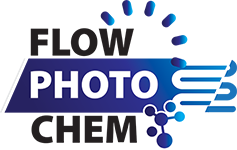Scientific Highlights
Concentrated Light
For the purposes of the research project, we use solar simulators; this enables our experiments to proceed without regard to weather or time of day.

Available high-flux solar simulators: (left) Xenon-High-Flux Solar Simulator (DLR, Germany); (middle) High-flux Solar Simulator (EPFL, Switzerland); (right) Sunlight (DLR, Germany)
Photo-electrochemical reactor (PEC)
This reactor uses concentrated light energy to drive a chemical reaction. We use a PEC reactor to split water into oxygen and hydrogen. The excess heat from this reaction feeds the PC reactor. We also use it to convert water and CO2 to solar syngas.
Using sunlight to split water into hydrogen and oxygen, and then storing the hydrogen, is a promising way to store solar power. State-of-the-art PEC technology typically achieves a sunlight-to-hydrogen efficiency in the region of 15%-20%. However, technologies typically rely on exotic and unstable catalytic materials, and/or an operating environment with very specific characteristics. This means that their costs, stability and robustness need to be improved upon.
In FlowPhotoChem, we use computer modelling to predict and design optimised catalysts, which combine high yield efficiency with long-term stability, and thus lower running costs.
Photo-catalytic reactor (PC)
This reactor uses light energy and the presence of a catalyst to trigger and drive a chemical reaction. We use a PC to combine CO2 with the hydrogen from the PEC, to produce CO, and/or ethylene (C2H4) and the base material for plastics.
Current PC reactors use exotic and expensive catalysts (transition and noble metals, such as iridium, ruthenium and gold); we will replace these with more affordable, readily available metal oxide semiconductors and doped graphenes, as well as metal-organic frameworks, laid down in nanoscale layers.
Electrochemical reactor (EC)
This reactor uses catalysts to stimulate the conversion of CO from the PEC into value-added products such as ethylene, ethanol, acetate and n-propanol.
Again, we will use computer modelling to design novel catalysts, this time specifically for CO reduction, as well as novel membrane systems to improve efficiency and current density of the cell.
Modular Reactor System
FlowPhotoChem breaks down the generation of useful chemicals using sunlight into several steps, each with its own modular reactor technology. This allows us to produce a broader range of chemicals compared to dedicated non-modular systems, because different combinations of reactors (PEC, PC and EC) can overcome kinetic barriers and thus lead to a variety of final chemicals. While multiple reactors are more expensive than a single dedicated reactor, the extra costs are worthwhile since the reactions and reactors can be optimised for each end product with higher efficiency and stability.
The benefits of our modular approach are:
- Each reactor can be optimised in isolation.
- The inter-connected modules will be integrated to maximise energy flow synergies, space-time yields, etc.
- The degradation of one reactor will have less effect on the overall system, and repair or replacement costs are reduced.
- The modular concept simplifies enhancements as the technology evolves, and as our own interim results emerge.
- The FlowPhotoChem system paves the way to scale up, as well as avoiding bottlenecks, enabling us to deploy multiple parallel copies of reactors.
Multiscale Modelling
A key scientific focus of FlowPhotoChem is the use of computer modelling to guide our experiments and our design and implementation work. We will create and derive great value from models of individual reactors, and of systems of multiple interlinked and integrated reactors; the models will help us to optimise coupled mass, charge and heat transport, and to understand and address limitations in components and materials.
In addition, we will use computational materials science techniques to identify promising catalysts for our innovative reactors, but with a particular focus on surface properties and defects.

